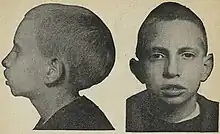| Dolichocephaly | |
|---|---|
 | |
| Dolichocephaly (scaphocephaly) in a 10-year-old | |
 | |
| Dolichocephalic head shape of Lurcher-type dogs | |
| Specialty | Medical genetics |
Dolichocephaly (derived from the Ancient Greek δολιχός 'long' and κεφαλή 'head') is term used to describe a head that is longer than average relative to its width. In humans, scaphocephaly is a form of dolichocephaly.
Dolichocephalic dogs (such as the Lurcher or German Shepherd) have elongated noses. This makes them vulnerable to fungal diseases of the nose such as aspergillosis.[1] In humans the anterior–posterior diameter (length) of dolichocephaly head is more than the transverse diameter (width).
Dolichocephaly can sometimes be a symptom of Sensenbrenner syndrome, Crouzon syndrome, Sotos syndrome,[2] CMFTD[3] and Marfan syndrome. However, it also occurs non-pathologically as a result of normal variation between human populations. The standards for denoting dolichocephaly are derived from Caucasian anatomy norms, and thus describing dolichocephaly as a medical condition may not reflect the diversity in different human populations.[4] For example, dolichocephaly is typical for Australian aborigines and native southern Africans.[5]
In anthropology, human populations have been characterized as either dolichocephalic (long-headed), mesocephalic (moderate-headed), or brachycephalic (short-headed). The usefulness of the cephalic index was questioned by Giuseppe Sergi, who argued that cranial morphology provided a better means to model racial ancestry.[6]
See also
References
- ↑ Ferreira, Rafael; et al. (2011). "Canine Sinonasal Aspergillosis" (PDF). Acta Scientiae Veterinariae. 39 (4): 1009. Retrieved 28 December 2014.
- ↑ Park SW, Park MS, Hwang JS, Shin YS, Yoon SH (2006). "A case of Sotos syndrome with subduroperitoneal shunt". Pediatr Neurosurg. 42 (3): 174–179. doi:10.1159/000091863. PMID 16636621. S2CID 12057084.
- ↑ Kliegman, Robert M.; Geme, Joseph St (2019-04-01). Nelson Textbook of Pediatrics E-Book. Elsevier Health Sciences. ISBN 978-0-323-56888-3.
- ↑ elementsofmorphology.nih.gov https://elementsofmorphology.nih.gov/index.cgi?tid=e09c1185a1ef3e38. Retrieved 2023-05-03.
{{cite web}}: Missing or empty|title=(help) - ↑ "Dolichocephaly | anatomy | Britannica". www.britannica.com. Retrieved 2023-09-19.
- ↑ K. Killgrove (2005). "Bioarchaeology in the Roman World" (PDF). M.A. Thesis, UNC Chapel Hill. Archived from the original (PDF) on 28 March 2012.
{{cite journal}}: Cite journal requires|journal=(help)
External links